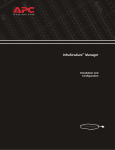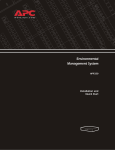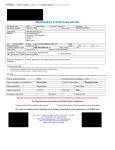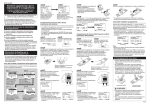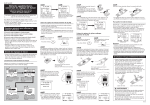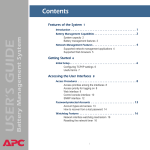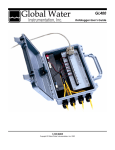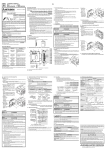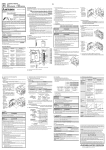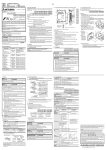Download APC AP9924 User's Manual
Transcript
Wire Harness for the Battery Management System AP9924 AP9926 AP9927 Installation Contents Preliminary Information . . . . . . . . . . . . . . . . . . . . . . . . . . . . . . . 1 Overview . . . . . . . . . . . . . . . . . . . . . . . . . . . . . . . . . . . . . 1 Silcon versus non-Silcon installation . . . . . . . . . . . . . . . . . . . 1 Inventory . . . . . . . . . . . . . . . . . . . . . . . . . . . . . . . . . . . . . 2 Safety Information. . . . . . . . . . . . . . . . . . . . . . . . . . . . . . . . . . . 3 Pre-installation Procedures. . . . . . . . . . . . . . . . . . . . . . . . . . . . . 4 Lockout/Tagout the UPS . . . . . . . . . . . . . . . . . . . . . . . . . . . 4 Determine battery numbers ........................ 4 Determine fuse bus and midpoint bus connections (Silcon only) 4 Install the Wire Harnesses . . . . . . . . . . . . . . . . . . . . . . . . . . . . . 6 How to install the tab washers on non-embedded terminals . . . 6 How to install tab washers on embedded battery terminals . . . 7 Prepare the harness wires . . . . . . . . . . . . . . . . . . . . . . . . . . 8 Install the battery and power fuses . . . . . . . . . . . . . . . . . . . 8 Connect the battery wires . . . . . . . . . . . . . . . . . . . . . . . . . . 9 Additional Silcon Connection Procedures . . . . . . . . . . . . . . . . . 10 Attach harness to the fuse bus and midpoint bus (Silcon only) 10 Install the 3/4 A and 5 A fuses (Silcon only) . . . . . . . . . . . . . 10 Secure the Wire Harness . . . . . . . . . . . . . . . . . . . . . . . . . . . . . 11 Secure the battery wires . . . . . . . . . . . . . . . . . . . . . . . . . . 11 Connect to the Battery Management System . . . . . . . . . . . . . . 12 Install the Battery Management System . . . . . . . . . . . . . . . . 12 String connection . . . . . . . . . . . . . . . . . . . . . . . . . . . . . . 12 Battery Connector Pinouts . . . . . . . . . . . . . . . . . . . . . . . . . . . . 13 Battery Diagrams. . . . . . . . . . . . . . . . . . . . . . . . . . . . . . . . . . . 14 Warranty and Service . . . . . . . . . . . . . . . . . . . . . . . . . . . . . . . 15 Limited warranty . . . . . . . . . . . . . . . . . . . . . . . . . . . . . . . 15 Warranty limitations . . . . . . . . . . . . . . . . . . . . . . . . . . . . 15 Obtaining service . . . . . . . . . . . . . . . . . . . . . . . . . . . . . . 15 Life-Support Policy. . . . . . . . . . . . . . . . . . . . . . . . . . . . . . . . . . 16 General policy . . . . . . . . . . . . . . . . . . . . . . . . . . . . . . . . . 16 Examples of life-support devices . . . . . . . . . . . . . . . . . . . . 16 Wire Harness: Installation i Preliminary Information Overview The Battery Management System for high voltage applications connects to one of the following: • A single APC Silcon UPS with pairs of strings. • A single non-APC UPS with single strings. The system provides battery management for nominal 2 V, 6 V, 8 V, or 12 V lead-acid batteries; or 1.2 V nickel-cadmium batteries. A system is comprised of at least one AP9921X master unit and up to five AP9921XS expansion units. Each unit supports up to 64 batteries. See also For more information on the features and capabilities of the Battery Management System, see the initial sections of the User’s Guide, which is available on the Utility CD supplied with the Battery Management System. Do not turn on the power to the unit until the wire harnesses are connected and the DIP switches are configured. Note Silcon versus non-Silcon installation This manual covers the installation of two types of systems: • An installation for an APC Silcon battery cabinet • An installation using 5-, 50-, or 100-foot wire harnesses, to be cut at installation to match your battery configuration The majority of the procedures in this manual are used for both system installations. Disregard Silcon-specific instructions (i.e., midpoint and fuse bus connections) if you are installing a generic harness to fit your battery cabinet or rack that is not for an APC Silcon UPS. Wire Harness: Installation 1 Preliminary Information Inventory Item 2 Quantity Wire harness 1 Ring terminal assemblies 3 3/4 A fuse (0W2237) 2 5 A fuse ( 0W2015) 38 Tab washers 38 Male Faston® connectors 5 Female Faston connectors 37 4-inch wire tie for 5-foot harness for 50-foot harness for 100-foot harness 20 80 80 8-inch wire tie for 5-foot harness for 50-foot harness for 100-foot harness 20 40 80 Wire Harness: Installation Safety Information Electrical Hazard Risk of electric shock: battery cabinets contain potentially lethal voltages! Batteries are energized even when AC power has been disconnected. Warning Only qualified personnel, trained in battery operation and safety, may install the harnesses. Keep unauthorized personnel away from the batteries. When installing the Battery Management System: • Cover the batteries with an insulating blanket before installing the harnesses. • Wear safety glasses, rubber gloves, and rubber boots. • Use double-insulated tools. • Do not short-circuit the battery terminals; a short circuit could cause the batteries to explode. • Do not lay tools or metal parts on top of the batteries or near the cable lugs. • Remove watches, rings, and other metal objects. • Use only cables supplied by APC unless otherwise indicated. • For the UPS and switch gear, use Lockout/Tagout safety procedures (which remove access to a device and physically label the device as intentionally out of service) before working on the batteries. Wire Harness: Installation 3 Pre-installation Procedures Lockout/Tagout the UPS Before installing the wire harnesses, use lockout and tagout safety procedures for the UPS or any attached equipment, such as high-voltage power supplies. If possible, disconnect the main output lead from the battery string to the load. Electrical Hazard Voltage is present in the battery cabinet even after disconnecting it from the main load. Use caution when working with the batteries. Determine battery numbers Before installing the harness wires, designate a battery number to each battery in your system. Using a volt meter to check polarity, determine the most positive battery in your string (Battery 1), and count to the most negative (last) battery in your string. Determine fuse bus and midpoint bus connections (Silcon only) Locate the 1/2-fuse bus connectors and 1/2-midpoint bus connectors on the inside roof of the cabinet. Fuse Bus Midpoint Bus • The positive fuse bus connectors and midpoint bus connectors are on the right side of the cabinet. • The negative fuse bus connectors and midpoint bus connectors are on the left side of the cabinet. 4 Wire Harness: Installation Pre-installation Procedures Determine what connections you need to make: 1. If you are installing harnesses in one cabinet, connect the following: • one positive 1/2-fuse bus (+ 1/2) connector • two positive 1/2-midpoint (+ 1/2) connectors • one negative 1/2-fuse bus (- 1/2) connector 2. If you are installing harnesses in two cabinets, connect the following: Cabinet A: • one positive 1/2-fuse bus (+ 1/2) connector • two positive 1/2-midpoint (+ 1/2) connectors Cabinet B: • two negative 1/2-fuse bus (- 1/2) connectors • one negative 1/2-midpoint (- 1/2) connector Wire Harness: Installation 5 Install the Wire Harnesses Before you attach the wire harnesses to the batteries, install a tab washer on the positive terminal of each battery to be managed. How you install the tab washer depends on whether the terminal bolt is embedded in the battery. How to install the tab washers on nonembedded terminals Note Do not disturb existing battery connections. Place the tab washers and nuts on top of the bolt thread extensions of the existing battery connections. You must provide your own nuts for tab washer installation. mph0157a 1. Install a tab washer onto the positive terminal of each battery to be managed. Note For Battery 1 and the last battery of String A, you must install additional tab washers to connect the Battery Management System unit power wires (String A wires 34 and 35). For each unit on the system, attach one additional tab washer. For example, a four-unit system would require five tab washers stacked on top of each other and offset on the positive terminal of both Battery 1 and the last battery of String A. This would include one tab washer to manage the battery and four tab washers to connect each unit’s power wire. 2. Secure each set of washers in place with a nut. 3. Coat the tab washers and nuts with approved antioxidant grease. Note 6 If you experience problems connecting wires to the terminals on the batteries, contact APC Customer Support at a number on the back cover of this manual. Wire Harness: Installation Install the Wire Harnesses How to install tab washers on embedded battery terminals Electrical Hazard Verify that the string is an open circuit before working with the batteries. mph0269a 1. Remove the bolt from a battery. mph0270a 2. Place the ring terminal on the existing battery connection, directly under the hex-head of the bolt. 3. Replace the bolt in the battery, and adjust its torque according to the battery manufacturer’s specifications. 4. Coat the tab washer and nut with approved antioxidant grease. Note Note For Battery 1 and the last battery of String A, you must install additional tab washers to connect the Battery Management System unit power wires (String A wires 34 and 35). For each unit on the system, attach one additional tab washer. For example, a four-unit system would require five tab washers stacked on top of each other and offset on the positive terminal of both Battery 1 and the last battery of String A. This would include one tab washer to manage the battery and four tab washers to connect each unit’s power wire. If you experience problems connecting to the terminals on the batteries, contact APC Customer Support at a number on the back cover of this manual. Wire Harness: Installation 7 Install the Wire Harnesses Prepare the harness wires To prepare the harness wires: 1. Measure the length of each wire so that it will reach from the positive terminal on its battery to the battery connector on the rear of the Battery Management System, adding a ‘service loop’ that will permit one repair of the wire without having to replace it. 2. For an APC Silcon unit, measure wires to connect to the fuse bus and midpoint bus located on the inside roof of the battery cabinet. See “Determine fuse bus and midpoint bus connections (Silcon only)” on page 4. 3. Cut the wires to the lengths measured in step 1 and step 2, and reattach the wire labels to the wire ends. 4. For an APC Silcon unit, attach the male Faston connectors to the fuse bus and midpoint bus wire ends, and crimp them securely in place. 5. Attach the female Faston connectors to the battery wire ends, and crimp them securely in place. Install the battery and power fuses Attach a 5 A fuse (0W2015) to the following wire connectors: • Strings A–33A • Strings 1B–33B, if applicable • String 35A (negative power wire) mph0261a Attach a 3/4 A fuse (0W2237) to String 34A (positive power wire). 8 Wire Harness: Installation Install the Wire Harnesses Slide the receptor end of each fuse over the tab portion on the washers that you installed on the positive terminals of each battery. Note Each wire is labeled with a number indicating its correct battery connection. For example, the battery labeled 1A would connect to Battery1 of String A, and so on. mph0111a Connect the battery wires For additional guidance on battery-wire connections, see the battery connector pinout on page 13 and the battery diagram on page 14. Wire Harness: Installation 9 Additional Silcon Connection Procedures Attach harness to the fuse bus and midpoint bus (Silcon only) Install the ring terminals onto the appropriate bolts on the fuse bus and midpoint bus: 1. Remove the nut from the bolt. 2. Slide the ring terminal onto the bolt. 3. Replace and tighten the nut. See “Determine fuse bus and midpoint bus connections (Silcon only)” on page 4 for the connections to make. Install the 3/4 A and 5 A fuses (Silcon only) To install the fuses onto the fuse bus and midpoint bus wires: One-cabinet system: 1. Install the 3/4 A fuse (0W2237) between the ring terminal assembly and the positive 1/2-string fuse bus wire. 2. Install 5 A fuses (0W2015) between the ring terminal assemblies and all other fuse bus and midpoint bus connections. Two-cabinet system: 1. Install a 3/4 A fuse (0W2237) on the positive 1/2-string fuse bus wire on the positive string harness (0W1492). 2. Install a 5 A fuse (0W2015) on the negative 1/2-string midpoint bus wire on the negative string harness (0W1491). 3. Install 5 A fuses (0W2015) between the ring terminal assemblies and all other fuse bus and midpoint bus connections. Midpoint Bus mph0107a Fuse Bus 10 Wire Harness: Installation Secure the Wire Harness Secure the harness to the rack or cabinet to prevent damage to the wires or personal injury by people tripping on them. Warning After the battery wires are connected, secure the harness wires. 1. Using the 4-inch wire ties, attach the battery wires to the battery straps. Attaching the wires too tightly could damage their insulation. mph0113a Caution 2. Using the 8-inch wire ties, secure the harness to the enclosure to prevent wire damage. mph 0114a Secure the battery wires Wire Harness: Installation 11 Connect to the Battery Management System Install the Battery Management System Install the Battery Management System in a battery cabinet, in a rack or enclosure, or on top of the battery cabinet. The system must be installed in a location that is safe, convenient, and accessible for connection procedures. See also String connection For instructions and safety information on installing the Battery Management System (AP9921X and AP9921XS), see the Battery Management System Installation and Quick Start manual (990-1649A), included with your Battery Management System. You can also obtain the manual and other documentation for currently available models of the Battery Management System at www.apc.com by searching for the product's part number (e.g., AP9921X). After attaching the wire harnesses to the batteries and securing the harnesses to the cabinets or racks, connect the battery strings to the Battery Management System. Note Verify that the ON/OFF button is in the OFF position on each Battery Management System before plugging in connectors. 1. Plug the connector for String A into the right rear of the Battery Management System in the port marked Battery/Power Input A. 2. If applicable, plug the connector for String B into the left rear of the Battery Management System in the port marked Battery Input B. 12 Wire Harness: Installation Battery Connector Pinouts Battery Connector A Battery Connector B Wire # Battery number and polarity Wire # Battery number and polarity 1 Battery 1 + 1 Battery 33 + 2 Battery 1 - and Battery 2 + 2 Battery 33 - and Battery 34 + 3 Battery 2 - and Battery 3 + 3 Battery 34 - and Battery 35 + 4 Battery 3 - and Battery 4 + 4 Battery 35 - and Battery 36 + 5 Battery 4 - and Battery 5 + 5 Battery 36 - and Battery 37 + 6 Battery 5 - and Battery 6 + 6 Battery 37 - and Battery 38 + 7 Battery 6 - and Battery 7 + 7 Battery 38 - and Battery 39 + 8 Battery 7 - and Battery 8 + 8 Battery 39 - and Battery 40 + 9 Battery 8 - and Battery 9 + 9 Battery 40 - and Battery 41 + 10 Battery 9 - and Battery 10 + 10 Battery 41 - and Battery 42 + 11 Battery 10 - and Battery 11 + 11 Battery 42 - and Battery 43 + 12 Battery 11 - and Battery 12 + 12 Battery 43 - and Battery 44 + 13 Battery 12 - and Battery 13 + 13 Battery 44 - and Battery 45 + 14 Battery 13 - and Battery 14 + 14 Battery 45 - and Battery 46 + 15 Battery 14 - and Battery 15 + 15 Battery 46 - and Battery 47 + 16 Battery 15 - and Battery 16 + 16 Battery 47 - and Battery 48 + 17 Battery 16 - and Battery 17 + 17 Battery 48 - and Battery 49 + 18 Battery 17 - and Battery 18 + 18 Battery 49 - and Battery 50 + 19 Battery 18 - and Battery 19 + 19 Battery 50 - and Battery 51 + 20 Battery 19 - and Battery 20 + 20 Battery 51 - and Battery 52 + 21 Battery 20 - and Battery 21 + 21 Battery 52 - and Battery 53 + 22 Battery 21 - and Battery 22 + 22 Battery 53 - and Battery 54 + 23 Battery 22 - and Battery 23 + 23 Battery 54 - and Battery 55 + 24 Battery 23 - and Battery 24 + 24 Battery 55 - and Battery 56 + 25 Battery 24 - and Battery 25 + 25 Battery 56 - and Battery 57 + 26 Battery 25 - and Battery 26 + 26 Battery 57 - and Battery 58 + 27 Battery 26 - and Battery 27 + 27 Battery 58 - and Battery 59 + 28 Battery 27 - and Battery 28 + 28 Battery 59 - and Battery 60 + 29 Battery 28 - and Battery 29 + 29 Battery 60 - and Battery 61 + 30 Battery 29 - and Battery 30 + 30 Battery 61 - and Battery 62 + 31 Battery 30 - and Battery 31 + 31 Battery 62 - and Battery 63 + 32 Battery 31 - and Battery 32 + 32 Battery 63 - and Battery 64 + 33 Battery 32 - 33 Battery 64 - 34 105–560 VDC power from (+) of first battery in first string. 34 NC – Do not use. 35 105–560 VDC power from (-) of last battery in first string. 35 NC – Do not use. 36 NC 36 NC Wire Harness: Installation 13 Battery Diagrams The following is an example battery diagram for two strings of 32 batteries or one string of 64 batteries. An example for one string of 32 batteries would include Connector A only. CONNECTOR B CONNECTOR A 1 + 2 + 3 4 5 6 7 8 9 10 11 12 13 14 15 16 17 18 19 20 21 22 23 24 25 26 27 28 29 30 31 32 1 2 1 + 2 + 3 4 5 6 7 8 9 10 11 12 13 3 14 6 7 8 9 10 11 12 13 14 15 16 16 17 18 19 20 21 22 23 24 25 26 27 28 29 30 31 32 17 18 19 20 21 22 23 24 25 26 27 28 29 30 31 32 To next unit 35 35 Power Switch (Inside each unit) Wire Harness: Installation 3 (35) 4 (36) 5 (37) 6 (38) 7 (39) 8 (40) 9 (41) 10 (42) 11 (43) 12 (44) 13 (45) 14 (46) 15 (47) 16 (48) 17 (49) 18 (50) 19 (51) 20 (52) 21 (53) 22 (54) 23 (55) 24 (56) 25 (57) 26 (58) 27 (59) 28 (60) 29 (61) 30 (62) 31 (63) 32 (64) 33 34 34 36 5 14 15 33 Power + Power Not used 4 1 (33) 2 (34) 36 Not used Not used Not used Warranty and Service Limited warranty APC warrants the wire harness to be free from defects in materials and workmanship for a period of two years from the date of purchase. Its obligation under this warranty is limited to repairing or replacing, at its own sole option, any such defective products. This warranty does not apply to equipment that has been damaged by accident, negligence, or misapplication or has been altered or modified in any way. This warranty applies only to the original purchaser. Warranty limitations Except as provided herein, APC makes no warranties, express or implied, including warranties of merchantability and fitness for a particular purpose. Some jurisdictions do not permit limitation or exclusion of implied warranties; therefore, the aforesaid limitation(s) or exclusion(s) may not apply to the purchaser. Except as provided above, in no event will APC be liable for direct, indirect, special, incidental, or consequential damages arising out of the use of this product, even if advised of the possibility of such damage. Specifically, APC is not liable for any costs, such as lost profits or revenue, loss of equipment, loss of use of equipment, loss of software, loss of data, costs of substitutes, claims by third parties, or otherwise. This warranty gives you specific legal rights and you may also have other rights, which vary according to jurisdiction. Obtaining service To obtain support for problems with your wire harness: 0 1. Note the serial number and date of purchase. You can locate the serial number on the box label. 2. Contact Customer Support at a phone number on the back cover of this manual. A technician will try to help you solve the problem by phone. 3. If you must return the product, the technician will give you a return material authorization (RMA) number. If the warranty expired, you will be charged for repair or replacement. 4. Pack the unit carefully. The warranty does not cover damage sustained in transit. Enclose a letter with your name, address, RMA number and daytime phone number; a copy of the sales receipt; and a check as payment, if applicable. 5. Mark the RMA number clearly on the outside of the shipping carton. 6. Ship by insured, prepaid carrier to the address provided by the Customer Support technician. Wire Harness: Installation 15 Life-Support Policy General policy American Power Conversion (APC) does not recommend the use of any of its products in the following situations: • In life-support applications where failure or malfunction of the APC product can be reasonably expected to cause failure of the lifesupport device or to affect significantly its safety or effectiveness. • In direct patient care. APC will not knowingly sell its products for use in such applications unless it receives in writing assurances satisfactory to APC that (a) the risks of injury or damage have been minimized, (b) the customer assumes all such risks, and (c) the liability of American Power Conversion is adequately protected under the circumstances. Examples of life-support devices The term life-support device includes but is not limited to neonatal oxygen analyzers, nerve stimulators (whether used for anesthesia, pain relief, or other purposes), autotransfusion devices, blood pumps, defibrillators, arrhythmia detectors and alarms, pacemakers, hemodialysis systems, peritoneal dialysis systems, neonatal ventilator incubators, ventilators (for adults and infants), anesthesia ventilators, infusion pumps, and any other devices designated as “critical” by the U.S. FDA. Hospital-grade wiring devices and leakage current protection may be ordered as options on many APC UPS systems. APC does not claim that units with these modifications are certified or listed as hospital-grade by APC or any other organization. Therefore these units do not meet the requirements for use in direct patient care. 16 Wire Harness: Installation Radio Frequency Interference a Warning Changes or modifications to this unit not expressly approved by the party responsible for compliance could void the user’s authority to operate this equipment. USA—FCC This equipment has been tested and found to comply with the limits for a Class A digital device, pursuant to part 15 of the FCC Rules. These limits are designed to provide reasonable protection against harmful interference when the equipment is operated in a commercial environment. This equipment generates, uses, and can radiate radio frequency energy and, if not installed and used in accordance with this user manual, may cause harmful interference to radio communications. Operation of this equipment in a residential area is likely to cause harmful interference. The user will bear sole responsibility for correcting such interference. Canada—ICES This Class A digital apparatus complies with Canadian ICES-003. Cet appareil numérique de la classe A est conforme à la norme NMB-003 du Canada. Japan—VCCI This is a Class A product based on the standard of the Voluntary Control Council for Interference by Information Technology Equipment (VCCI). If this equipment is used in a domestic environment, radio disturbance may occur, in which case, the user may be required to take corrective actions. この装置は、情報処理装置等電波障害自主規制協議会(VCCI)の基 準に基づくクラス A 情報技術装置です。この装置を家庭環境で使用 すると、電波妨害を引き起こすことがあります。この場合には、使 用者が適切な対策を講ずるように要求されることがあります。 APC Worldwide Customer Support Customer support for this or any other APC product is available at no charge in any of the following ways: • Visit the APC Web site to access documents in the APC Knowledge Base and to submit customer support requests. – www.apc.com (Corporate Headquarters) Connect to localized APC Web sites for specific countries, each of which provides customer support information. – www.apc.com/support/ Global support searching APC Knowledge Base and using e-support. • Contact an APC Customer Support center by telephone or e-mail. – Regional centers: Silcon Customer Support (1)(877)287-7835 (toll free) APC headquarters U.S., Canada (1)(800)800-4272 (toll free) Latin America (1)(401)789-5735 (USA) Europe, Middle East, Africa (353)(91)702000 (Ireland) Japan (0) 35434-2021 Australia, New Zealand, South Pacific area (61) (2) 9955 9366 (Australia) – Local, country-specific centers: go to www.apc.com/support/contact for contact information. Contact the APC representative or other distributor from whom you purchased your APC product for information on how to obtain local customer support. Entire contents © 2005 American Power Conversion. All rights reserved. Reproduction in whole or in part without permission is prohibited. APC, the APC logo, InfraStruXure, and Silcon are trademarks of American Power Conversion Corporation and may be registered in some jurisdictions. All other trademarks, product names, and corporate names are the property of their respective owners and are used for informational purposes only. 990-1813B *990-1813B* 04/2005




















